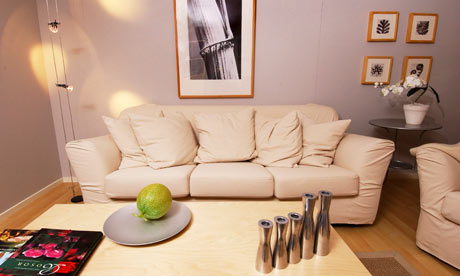1990s interiors
Taken from then summarised by myself:
When the '90s rolled
around, people were over the penny pinching designs from the '80s, which
included piecing together different patterns of wallpaper and made for some
clashing designs. 1990 began an era of minimalism where beige and white ruled
the early decade. Slowly, patterns began creeping into the popular aesthetic,
and like a stealth revolution, the hunger for some color erupted in a
floral and damask explosion. In the '90s, we invested in some pretty silly
products like balloon chairs and beer signs, and although we loved them at the
time, for the sake of design, we hope they don't make a comeback.
The 90s were awash with an
indistinct colour scheme of beige, white and more beige, the palette of choice
for buy-to-letters dressing their warehouse bachelor pads.
Whereas in the 90s it was
all about buying brand new and slapping it on the credit card, the noughties -
or at least the latter, recession-hit part - was about upcycling: reclaiming
one man's junk as another's vintage treasure to make-do-and-mend.
In the 90s, we were still
learning what it meant to go green; in the noughties we started to put it into
practice. The likes of TV's Grand Designs,
which launched in 1999, nurtured the concept of energy-saving ecohomes. Now
there are eco-living home boutiques selling everything from bamboo towels to paper chairs.
Taken from the Geffrey Museum
http://www.geffrye-museum.org.uk/period-rooms-and-gardens/explore-rooms/loft-style-apartment-1998/

Taken from the Geffrey Museum
http://www.geffrye-museum.org.uk/period-rooms-and-gardens/explore-rooms/loft-style-apartment-1998/
Loft-style apartment, 1998
A loft-style apartment in 1998 photographed by Chris Ridley
The conversion of commercial buildings into domestic living spaces or ‘lofts’ was first undertaken in London during the 1970s in redundant riverside warehouses. It has since become one of the main forms of housing development in inner London. This room is typical of an architect-designed loft in a nineteenth-century warehouse, with the kitchen, living and dining areas all in one, open space. The mezzanine over the kitchen allows space for a bedroom while the bathroom (to the right) is designed with a back-lit, glazed wall to provide light in the areas furthest from the windows.
The main features associated with this style of interior are bare wood flooring, white walls, sparse furnishings and modern furniture. Colour can be provided by the upholstery, a few decorative objects, such as coloured-glass vases, and a large contemporary painting or print. Sometimes, as shown here, a section of wall is picked out in a bright, accent colour. The style has spread from lofts to ordinary houses, where it has become fashionable to install new wood flooring and contemporary furniture. Perhaps the most enduring feature of lofts has been the inclusion of the kitchen within the main living space and many townhouses have since been opened up inside to create a large ‘living kitchen’ where all of the family and friends can gather.
SUMMARY of 90s
-clashing to minimalist
(distance from loud 80s boom boom era)
-beige and whites ruled
early 90s (hints of colour in the form of pastels)
-pattern began to
re-emerge in the form of colour floral/ damask
-PINE furniture
-“shabby chic”
-oversized slipcovered
sofas
-1987 opening of IKEA-
flourished in 90s










No comments:
Post a Comment